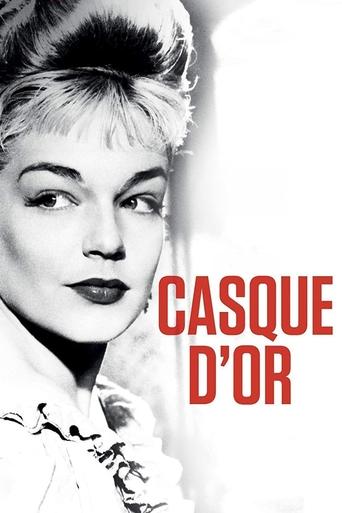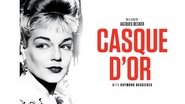christopher-underwood
This is a dream of a movie. Not full of action, yet packed with memorable moments and whole sequences. The stunning opening with the rowing boats on the river and the singing accompaniment, the slow build up and rapid denouement of the execution at the end and so much more in between. I was surprised upon opening my DVD to see the film originated in 1952 because I had imagined I had seen it upon it's London film release. The, thanks to another IMDb reviewer, I discover that the film was quickly pulled upon initial release and not released again until nine years later when it is perfectly feasible that I saw it in the West End. Simone Signoret! What can one say? Even to a youngster today, used to seeing 'stars' come and go so easily, would surely appreciate the subtle allure that seemed to come so naturally to this beautiful woman, who invigorated so many excellent films.
R. Ignacio Litardo
Not being a Becker fan *at all* I guess I can be objective. This film is enjoyable like if it weren't a classic. Once begun, you'll want to watch it till the end. Simone looks gorgeous here, IMDb reviewer "pzanardo" from Padova, Italy is right when he writes that the director seems to have filmed her specially well. By the way, have you noticed how bad Italians fare on French period films? Thérèse Raquin (1953) from the next year is one of a string of examples...The Mafia aspect is so naive it's almost lovable in comparison with nowadays'. So is the city, the police, the woman/man relationships, class divisions... Félix Leca's character is stereotype incarnate, but at the same time very "believable", in spite of his constant narcissism and tics.Trevor Willsmer on Amazon is right at why it works: we expect a romantic period piece but during the knives fight in the beginning we realize crime is never nice, only made to look so. Yet somehow, our aesthetically expectations still are about something "nice", while the plot is dark. The police seems like a pantomime, in most of the film the State seems to be absent, and Félix the only one who does the thinking for everybody. The romance is almost enhanced by the heavy censorship. Nothing whatsoever is "shown" (even a kiss on the grass turns into the sky :)) but you feel enough passion. Signoret specially knows how to vibrate with a swagger attitude. Look at her entering a bar, greeting everybody, self assured and always knowing how to deal with men. Manda on the contrary, is a "too perfect hero" to be of my liking. My favourite scene is when he's doing nothing with a branch and she takes the initiative: "Kiss me" and then we have to watch the sky, if not, we'll burn :).Randy Buck on Amazon is right the film has a sort of documentary feel totally lacking in "Gangs of New York", that Willsmer writes was heavily influenced by this gem. Then only moment Félix Leca looses the grip of authority is when he is responsible of Raymond's death. Even thugs have rules... On the contrary, when they dispose of the blonde barman who talked too much, only the dumbest of them feels sorry for it.It's true it's not exactly believable that a mobster would be so cautious and "Machiavellian" when he could just grab and use the lady, but, sincerely, I don't care for feasibility in this sort of films.It's only with a twinge of nostalgia that I corroborate the swarm of reviewers & fans this film has. I'm absolutely glad about it, as of having watched this film.
rhoda-1
Despite the corsets and petticoats and horse-drawn cabs, this lush, richly textured film has more in common with the bleak, fatalistic modern-dress films of the period than with conventional historical romance. The action takes place over the course of only a few days, but in France that's long enough for a passion strong enough to change a life, or end it--more than one man dies because of the bewitching Marie and her golden hair that shines like the sun. The intensity of the characters' emotions and the suddenness of their violence is powerfully countered by the reserve of the playing--of the solemn, laconic toughs and of Simone Signoret as Marie. In moments of great emotion, her slight smile changes to a broad one, but with her lips still closed. There's none of the giggling and wriggling that marked the other blonde Fifties sex symbols, Bardot and Monroe, and countless others since, and obviously no nudity, total or partial, but in her morning-after scene with Serge Reggiani, you can practically smell smoke.Like Zola's Nana, Marie is neither a villain nor a victim, simply an elemental force of nature. This elemental-woman business can, in French and non-French movies, be pretentious and unwittingly comic, but there's none of that here, because neither Signoret nor the director indulge in any fancy dialogue or vocal tricks to play up how alluring she is--they don't have to. We are always aware of Marie as a figure of enormous strength, with a broad, strong back, round shoulders spilling out of her blouse, and a mouth too wide for coyness.In an otherwise favourable review, Pauline Kael said that the film's tone was slightly trashy, as if it were saying, of the low-life characters, "Look, they have feelings too." I disagree--the scene of the wealthy, slumming group in evening dress who find the characters "marvelously amusing" show us what Becker thinks of that viewpoint and implicitly reproaches anyone who shares it.
frankgaipa
One more memory game: I'd been wanting to re-see this for years after a single Pacific Film Archive screening I'm not sure what decade. Memories of style as attack, attack by aura, dancers and fighters tracing curves across the screen. Manda's one-armed grab of Marie's waist the first time he dances with her. All the film's men swaggering, strutting, dancing with pointed nonchalance. Cummerbund things. Caps, derbies. Knives. Guns?! Yes, there are guns, but those I'd forgotten. The knife fight that my memory placed near the end, High Noon style, actually starts things moving. Maybe -- I'm only slightly ashamed to say it since I know hundreds of French films -- a little bit of Chuck Jones' or Pepe le peu's France had leeched into what I remembered. Or maybe it was Popeye introduced me to apache dancers.So now I own it. Most of the story returns as I watch.Just one small thing I want to say though, that anyone else might not, has to do with what photographers call highlights. Only two characters, Marie "Casque d'or" and her Manda, get eye sparkles. Especially when they're with each other or thinking of the other or her eyes are tearing, Becker and his photographer allow a bit of maxed out exposure, to us gleam, a twinkle, a tiny bit of white screen in a black pupil. Did they manually scrape the film to allow light to show through? Some when zoomed in upon look like little crosses, or multi-pointed stars with long axes. They're quite intricate. I've never developed film, but know from converting digital images in my editing software to black and white that this is both difficult to achieve naturally with a camera and difficult to create after the fact so as to look natural. But it's no lucky stroke that the two lovers' eyes gleam. Becker did it. The only other character allowed this sparkle is Leca, a single instance, I think right before he forces himself on Marie.Light laces the film's parts. The boats of the opening emerge from a silver white landscape as simply, deceptively simply, conceived as sumi-e. The girls and the gang soon turn the light into motion on the dance floor. The "swells" are light, as is any and every sheet Marie has lain upon. Does the guillotine blade sparkle? Probably not. I've forgotten again already.Touch points? Not for light, but for motion, dance, and both male and female confidence and swagger: Carlos Saura's Carmen and Blood Wedding.





